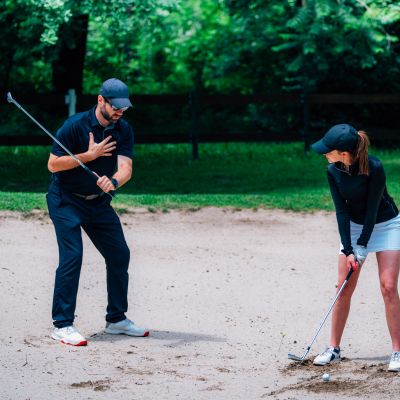What Factors Influence Your Golf Game The Most?

Every golfer dreams of achieving success on the golf course, seeking the secret to unlocking their full potential and lowering their handicap. While many golfers focus on perfecting their swing or mastering specific shots like drives, chips, or putts, they often overlook the fact that there are multiple factors influencing their performance.

In this comprehensive exploration, we will explore three key factors that significantly influence a golfer’s performance: the swing, the type of iron used, and the selection of the golf ball. Each of these elements has its own unique characteristics that can greatly impact your game. By gaining a better understanding of how these factors work together, you will be able to make more informed decisions and improve your overall performance.
The Iron: Choosing the Perfect Weapon
When it comes to your golf game, the choice of iron golf clubs can make a significant impact on your performance. Selecting the right iron for each shot is crucial for achieving the desired distance, accuracy, and trajectory.

Types of Irons:
There are several types of irons, including long irons (2-4), mid-irons (5-7), and short irons (8-9, plus pitching wedge). Each iron has a specific purpose and is designed to achieve varying distances and trajectories. Long irons offer more distance but require greater swing speed and precision, while short irons provide control and accuracy for shorter shots.
Loft Angle:
The loft angle of an iron determines the trajectory and distance of the shot. Higher lofted irons (e.g., 9-iron) have a steeper angle and generate higher shots with more backspin, making them ideal for approaches to the green or shots that require stopping quickly. Conversely, lower lofted irons (e.g., 3-iron) have a flatter angle, resulting in lower ball flight and more roll-out.
Clubhead Design:
The design of the iron’s clubhead influences forgiveness, playability, and feel. Game improvement irons feature a cavity back design, with weight distributed around the perimeter to increase forgiveness and help with off-center hits. On the other hand, players’ irons have a smaller sweet spot but offer enhanced control and workability for skilled golfers.
Shaft Selection:
The shaft of an iron affects the overall performance and feel of the club. Shafts come in different flexes, such as regular, stiff, or extra stiff, catering to varying swing speeds and preferences. Additionally, shaft material, such as steel or graphite, influences the weight, flexibility, and vibration dampening properties of the iron.
Club Fitting:
Club fitting plays a vital role in choosing the right set of irons. Getting custom-fitted by a professional ensures that your irons are tailored to your unique swing characteristics, including your height, swing speed, and swing path. A proper club fitting session considers factors such as lie angle, grip size, and shaft specifications to optimize your iron performance.
Choosing the right set of irons that suit your game and provide the desired ball flight is crucial. It’s essential to consider factors like forgiveness, workability, and feel when selecting irons that complement your playing style.
The Swing: Mastering the Foundation of Your Game
Your swing is the backbone of your golf game, influencing every shot you take. It involves the mechanics, technique, and overall execution of the golf shot. A well-executed swing leads to accuracy, power, and consistency. Factors such as the grip, posture, alignment, tempo, and balance all contribute to a successful swing. Practice, training, and refining the swing over time are essential for improvement.

Grip:
The grip is the foundation of your swing and has a significant impact on your control and feel of the club. The most common grips are the overlapping, interlocking, and baseball grip. Experiment with each grip and find the one that feels most comfortable and secure for you. Remember to grip the club firmly but not too tight, allowing for freedom of movement and a natural release through impact.
Posture:
Proper posture sets the stage for a balanced and powerful swing. Start by standing tall with a slight bend in your knees, maintaining a neutral spine angle. Avoid slouching or hunching over the ball, as this can restrict your rotation and lead to inconsistent strikes. Practice maintaining a solid posture throughout your swing, which allows for a full and unrestricted rotation of your upper body.
Alignment:
Alignment refers to the positioning of your body and club in relation to the target. Proper alignment ensures that your swing path is on target and helps you aim accurately. Before each shot, visualize an imaginary line extending from your target and align your feet, hips, and shoulders parallel to that line. Use alignment aids, such as intermediate targets or alignment sticks, to reinforce proper alignment during practice sessions.
Tempo and Rhythm:
Tempo and rhythm are essential for a smooth and coordinated swing. Find a tempo that feels natural to you, allowing for a fluid transition between your backswing and downswing. Avoid rushing or decelerating your swing, as it can lead to inconsistent contact and loss of power. Practice swinging with a metronome or counting in your head to develop a consistent and even tempo.
Balance and Weight Transfer:
Maintaining balance and executing a proper weight transfer are crucial for generating power and stability in your swing. Start with a balanced setup, distributing your weight evenly between both feet. As you initiate your backswing, transfer your weight to your trail side (right side for right-handed golfers) while maintaining a stable lower body. During the downswing, shift your weight onto your lead side (left side for right-handed golfers) for maximum power and a controlled release through impact.
Correcting Swing Flaws:
Even the best golfers encounter swing flaws at times. Common swing flaws include slicing, hooking, topping, or hitting fat shots. Understanding the causes of these issues is key to correcting them. For example, slicing often stems from an open clubface at impact, while topping the ball may result from lifting the upper body prematurely. Seek guidance from a golf instructor or use training aids to address specific swing flaws and practice drills that promote proper mechanics.
The Power of Practice: Taking Your Game to the Next Level

For golfers seeking to improve their skills and elevate their game, there is no substitute for the power of practice. Consistency and dedication in practice routines are essential elements that can unlock their true potential on the course. By emphasizing the importance of structured practice sessions and targeted drills, golfers can make significant strides in their game.
Establishing a regular practice schedule forms the foundation for improvement. With focused and deliberate practice, golfers can develop muscle memory, refine their techniques, and enhance their overall performance. By incorporating warm-up exercises, targeting specific areas of their game, and implementing drills that address key aspects such as putting, chipping, and driving, golfers can fine-tune their skills and track their progress by setting achievable goals.
In addition to solo practice, seeking professional guidance through a golf instructor or joining a golf clinic can provide valuable benefits. Working with an experienced instructor offers personalized insights into swing mechanics, course management, and mental approach. These instructors can identify and correct any flaws in technique, recommend tailored drills, and offer individualized advice based on the golfer’s unique playing style. Joining a golf clinic allows golfers to learn in a supportive and motivating environment, alongside other passionate players.
By embracing the power of practice, utilizing consistent routines and targeted drills, and seeking professional guidance, golfers can refine their skills, build confidence, and elevate their game to new heights. With dedication and commitment, the benefits of practice can be realized, leading to improved performance and a more enjoyable golfing experience.
The Golf Ball: Unleashing Your Potential
The golf ball may seem like a small detail, but its impact on your game is significant. Understanding the key factors that influence golf ball performance can help you make informed decisions when selecting the right ball for your game.

Compression, cover material, and dimple pattern are among the key elements that affect golf ball performance. Compression determines the ball’s softness or firmness, with low compression suitable for slower swing speeds and high compression for faster swing speeds. The cover material, such as Surlyn or urethane, affects control, feel, and spin. Meanwhile, the dimple pattern on the ball’s surface optimizes lift and reduces drag, influencing distance, trajectory, and stability in flight.
When choosing a golf ball, consider your swing speed, spin preferences, and playing conditions. Finding a ball that aligns with these factors will enhance your performance on the course and unlock your true potential.
To maximize value without compromising quality, you may also consider purchasing premium used golf balls. Golf Ball Monkey is a reputable source where you can find high-quality used golf balls at affordable prices. These premium used balls can offer excellent performance and savings compared to buying new. Explore their selection and take advantage of their grading system to ensure you choose balls in optimal condition.
By understanding the key factors that influence golf ball performance and considering options like premium used golf balls, you can elevate your game and experience the full potential of your skills on the golf course.
Conclusion:
In the game of golf, it is essential to recognize that there are many factors that can affect performance beyond just the swing, iron selection, and golf ball choice. These include mental focus, course management, physical fitness, and even external factors like weather conditions. Professional golfers constantly strive to improve and optimize these aspects of their game. By dedicating time and effort to refining these factors, they enhance their performance and achieve success on the golf course.
The insights shared here provide a better understanding of the various elements that contribute to success in this wonderful sport. Remember to keep swinging and enjoy the game to its fullest!

